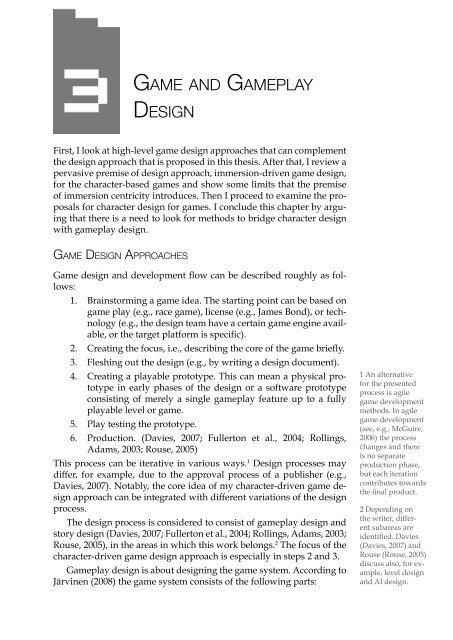Character Driven Game Design
Character Driven Game Design
Character Driven Game Design
You also want an ePaper? Increase the reach of your titles
YUMPU automatically turns print PDFs into web optimized ePapers that Google loves.
<strong>Game</strong> and <strong>Game</strong>play<br />
<strong>Design</strong><br />
First, I look at high-level game design approaches that can complement<br />
the design approach that is proposed in this thesis. After that, I review a<br />
pervasive premise of design approach, immersion-driven game design,<br />
for the character-based games and show some limits that the premise<br />
of immersion centricity introduces. Then I proceed to examine the proposals<br />
for character design for games. I conclude this chapter by arguing<br />
that there is a need to look for methods to bridge character design<br />
with gameplay design.<br />
<strong>Game</strong> <strong>Design</strong> Approaches<br />
<strong>Game</strong> design and development flow can be described roughly as follows:<br />
1. Brainstorming a game idea. The starting point can be based on<br />
game play (e.g., race game), license (e.g., James Bond), or technology<br />
(e.g., the design team have a certain game engine available,<br />
or the target platform is specific).<br />
2. Creating the focus, i.e., describing the core of the game briefly.<br />
3. Fleshing out the design (e.g., by writing a design document).<br />
4. Creating a playable prototype. This can mean a physical prototype<br />
in early phases of the design or a software prototype<br />
consisting of merely a single gameplay feature up to a fully<br />
playable level or game.<br />
5. Play testing the prototype.<br />
6. Production. (Davies, 2007; Fullerton et al., 2004; Rollings,<br />
Adams, 2003; Rouse, 2005)<br />
This process can be iterative in various ways. 1 <strong>Design</strong> processes may<br />
differ, for example, due to the approval process of a publisher (e.g.,<br />
Davies, 2007). Notably, the core idea of my character-driven game design<br />
approach can be integrated with different variations of the design<br />
process.<br />
The design process is considered to consist of gameplay design and<br />
story design (Davies, 2007; Fullerton et al., 2004; Rollings, Adams, 2003;<br />
Rouse, 2005), in the areas in which this work belongs. 2 The focus of the<br />
character-driven game design approach is especially in steps 2 and 3.<br />
<strong>Game</strong>play design is about designing the game system. According to<br />
Järvinen (2008) the game system consists of the following parts:<br />
1 An alternative<br />
for the presented<br />
process is agile<br />
game development<br />
methods. In agile<br />
game development<br />
(see, e.g., McGuire,<br />
2006) the process<br />
changes and there<br />
is no separate<br />
production phase,<br />
but each iteration<br />
contributes towards<br />
the final product.<br />
2 Depending on<br />
the writer, different<br />
subareas are<br />
identified. Davies<br />
(Davies, 2007) and<br />
Rouse (Rouse, 2005)<br />
discuss also, for example,<br />
level design<br />
and AI design.
















